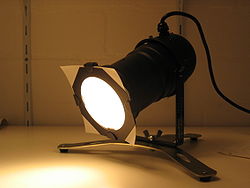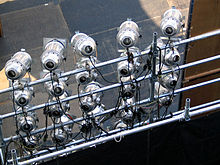- Parabolic aluminized reflector light
-
A parabolic aluminized reflector lamp (also PAR light, PAR can, or simply PAR) is a type of electric lamp that is widely used in commercial, residential, and transportation illumination. Usage includes locomotive headlamps, aircraft landing lights, and residential and commercial recessed lights ("cans" in the United States). They are identical in principle to sealed beam automobile headlights.
This article covers only their use in stage lighting. The lamps and their fixtures are widely used in theatre, concerts and motion picture production when a substantial amount of flat lighting is required for a scene.
In situations where sunlight or other specular light is available, a white foam reflector is often used to accomplish the same effect as a PAR array.
PAR cans are being replaced in some applications by LED PAR cans, which use less electric power and produce a wide array of saturated colors without the use of color filters, when white light is not needed.
Contents
Construction
PAR lights possess a lens and reflector that are integral parts of the lamp, the position of which cannot be altered relative to the filament. A notable exception is ETC's Source Four PAR, which uses the same halogen lamp as their Source Four ERS. In this case, the lens is a separate piece from the lamp. The relative position of lamp and lens remains unalterable.
In PAR 64s, Raylite reflectors and two pin base lamps are often used as a cheaper alternative as the lamp is replaced but the reflector remains. Lamps such as the 500 watt A1/244 can be as much as half the price of the sealed beam units. Par 64's also often run at 120 V, in two-pair series channels, with a "y" Splitter at the dimmer. Narrow, medium and wide Raylite reflectors are quite readily available. The two-blade (pin) Mogul lamp connector need not be replaced — this is integral to the Raylite reflector, although some Raylite reflectors have "tails" which then require connection to the mains flex with the use of a ceramic connector block (ideally fixed to the can's body).[1]
Effects
The sealed beam lamp produces an intense oval pool of light with unfocused edges. The only focus adjustment is a knob that allows the lamp/lens unit to be rotated within its casing, thus changing the orientation of the oval. With some models this control is via the mogul ceramic connector which connects directly to the Mogul prongs of the lamp. With the SourceFour PAR, the interchangeable lens is what is rotated. Therefore, the diameter of the light spot is defined by the aluminium reflector, and cannot be adjusted without changing the lamp. The type of lamp includes extra-wide flood (XWFL), wide flood (WFL), medium flood (MFL), narrow spot (NSP), and very narrow spot (VNSP).
These types of instruments come in varying diameters, the most common being designated PAR56 and PAR64. The number indicates the diameter of the housing in eighths of an inch (so a PAR64 is eight inches (~20 cm) in diameter).
Uses
PAR lights are often used in theatrical or live music shows. Commonly they are used to generate colours by fitting them with colored sheets called gels. The cans are arranged into rows of different colours and identical rows placed on different sides of the stage. Due to their affordability, they are ideal for colour washes in several different colours. However, because of the lack of control over the beam diameter, shape and sharpness, PARs are rarely used as front of house lights other than for front washes but can be used for special effect lighting such as lighting from directly above or from extreme angles as well as general wash lights overhead/above stage. If used cleverly, par cans can provide low budget productions with good effects.
Variations
Diameter
Nominal lamp bell diameter in inches is found by dividing the PAR size by 8. For example, a PAR30 lamp is approximately 3.75 inches in diameter.
Designation Nominal Dia.
(inch)Nominal Dia.
(mm)PAR64 8 200 PAR56 7 175 PAR46 5.75 145 PAR38 4.75 120 PAR36 4.5 115 PAR30 3.75 95 PAR20 2.5 65 PAR16 2 50 Note: PAR16 is also known as a "birdie" in theatre, as it is "below par", an oblique reference to a term used in the game of golf.
Beam width
Depending the parabolic reflector geometry and placement of the filament within the paraboloid, PAR lamps can achieve a wide range of beam widths, from narrow spot to wide flood. For lighting effects even wider than wide flood can provide, supplemental reflectors or lenses can be used. The following suffixes are commonly used with PAR lamps to indicate their beam width:
Description Suffix Very Narrow Spot CP60 Narrow Spot CP61 Medium Flood 1 CP62 Wide Flood CP95 Standard Power Ratings
PAR64
- 1000 W
- 500 W
- 250 W (ACL)
PAR56
- 500 W
- 300 W
- 200 W
PAR38
- 150 W
- 100 W
- 75 W
Each lamp type is available in 110 V or 220 V rating, depending on the common mains voltage for a locale, except ACL PAR, whose light beam is more compact and nominal operating voltage is 28 V. ACL PAR is a type of projector primarily used in aviation, before being used on stage for light path effects. In the UK, ACL pars are typically used together with four mounted together on a bar, and two bars run in series together in order to work on a dimmer with 240v supply voltage. In Europe, where the mains voltage is between 220 and 240v, it is common to use series pairs of 110v lamps because the thicker filament is much less liable to vibration-induced fracture; an important consideration for touring rigs and music venues.
Raylite reflector
Raylite reflectors can be added to PAR64 and PAR56 lamp housings to achieve a narrow spot effect. A conventional quartz halogen lamp is used in place of the reflector lamp. A spider or bulb shield may optionally be added, which enhances the parallel nature of the beam and makes it more visible when used with smoke or fog effects. Raylites are generally less rugged than sealed beam bulbs. The lamp can easily shake loose of the lampholder in transit.
Finish
PARs are found commonly with either black finish or polished (silver). PARs can occasionally be found in white.
Non-sealed PAR alternatives
The Source Four PAR and similar units create light with a similar quality to that of a PAR can, but have lenses separate from the lamp.
LED
An LED version of the PAR is made by some manufacturers.
LED PAR cans usually are based on an RGB color model.
PARbars
PARbars are PARs that are permanently affixed to and circuited through an aluminum pipe. Four PARs on a bar are called a 4-bar. 6 PARs are called 6-bars. Typically mains multicore cabling will be used to supply power to the bars, so that only one connection has to be made, thus saving assembly time and giving a neater appearance.
Daylight PARs
HMI PARs produce light with a color temperature equivalent to that of sunlight.
PAR movers
Intelligent, moving PARs allow for the ability to pan and tilt the instruments through a lighting control console. These have been generally superseded by dedicated intelligent lighting fixtures, which use a different light source and offer more control over the colour and shape of the beam.
Combination instruments
- The Source Four PARnel combines the attributes of the PAR can and the Fresnel.
- OmniSistem makes a "Profile PAR", combining the attributes of the PAR can and an ellipsoidal reflector spotlight.
See also
- Stage lighting instrument
- Stage lighting accessories
References
Stagecraft Theatrical scenery
(Scene shop)FieldsHardwareStage lighting FieldsHardwareBarn doors · Color gel · Color scroller · Cyclorama · Gobo · Lighting control console · Stage pin connector · Top hat · Theatrical fogBeam projector · Ellipsoidal reflector spotlight · Fresnel lantern · Intelligent lighting · Parabolic aluminized reflector light · Scoop · Striplight · AccessoriesOther Fields Lamps and lighting Incandescent Fluorescent High-intensity
discharge (HID)Mercury-vapor · Hydrargyrum medium-arc iodide (HMI) · Hydrargyrum quartz iodide (HQI) · Metal halide (Ceramic) · Sodium vaporGas discharge Deuterium arc · Neon · Sulfur · Xenon arc / Xenon flash · Black light · Tanning lamp · Germicidal · Growth lightElectric arc Combustion Other Lamp (electrical component) · Light fixture · Lightbulb sockets · Light-emitting diode (LED) · LED lamp · Solid-state (SSL) · Plasma · Electroluminescent wire · Chemiluminescence · Radioluminescence · Glow stick · ESLCategories:- Incandescent light bulbs
- Stage lighting instrument
- Cinematography
Wikimedia Foundation. 2010.


